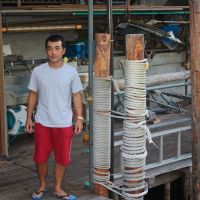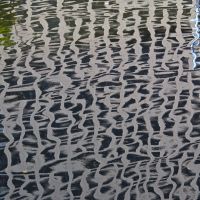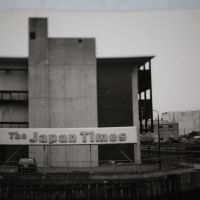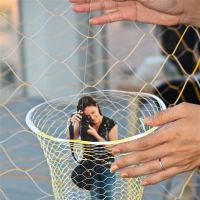There's an expression in Japanese — Todai moto kurashi (The base of the lighthouse is dark) — which occurs to me as I leave the headquarters of The Japan Times in Shibaura. Though I regularly dock here, I realize I'm in the dark about the surrounding area, Minato Ward's manmade flatlands in Tokyo's southeast.
With a skyline lorded over by residential and office skyscrapers, I soon discover that Shibaura's only backstreets are its networks of canals, most of them now flanked with relatively new and pleasant boardwalks.
Until late in the Meiji Era (1868-1912), the Shibaura area consisted of a grassy shoreline, home to fishermen and clam-diggers. A nearby promontory, Tsuki no Misaki (near present-day Kamezuka Park), was famous for its moon-viewing vista over the shore below and out to sea. The promontory still exists, but by the end of the Meiji Era it had lost its appellation because new buildings on the landfilled margins of Tokyo Bay had begun to obscure the view.
Following a fishy breeze in the general direction of the sea, I'm surprised by its source: a laundry line of smelt (which I'd smelt) drying outside restaurant Ikku. Owner Issei Sekiguchi, 42, informs me his neat 12-seater doesn't open until evening, but he offers boxed lunches of fish for ¥600. It's still early for lunch, so I drift away.
At Yachiyo Bridge, I admire a few boats bobbing below a sign advertising various types of cruises. At the streetside entrance to Ishikawa, a tsurifune (fishing boat) and yakatabune (pleasure boat) rental company, I meet 43-year-old Yu Izuo who, from age 7, has worked in the business begun back in 1919. "My great-grandfather harvested seaweed in this area," Izuo says, giving me a glimpse of pre-Meiji Shibaura.
A young "old salt" with a deep tan, Izuo boards one of his recreational fishing boats as we talk. Charters, he tells me, run from about 8 a.m. to 3 p.m., and for a group of five the cost is about ¥10,000 each. "Even beginners can catch shiro kiso (whiting) or iidako (baby octopus)," he says with an encouraging smile.
Ishikawa's pleasure boats, low-riders of the waves, are dark inside, their tables stowed on tatami mats in an orderly fashion that belies the rollicking parties they ferry about at night. Reservations must be made at least a month in advance and require a minimum of 15 guests — but for ¥10,500, Izuo's patrons get dinner, karaoke and unlimited drinks.
"Drunk people can fall off the boat, so we warn people not to overdo it. We're all about safety first," Izuo remarks, as his wife scoots behind him with vegetables to be prepared for the evening's cruise. Seeing they are busy, I bid them bon voyage.
In the noon heat, I follow visored saleswoman Tsueko Wada hauling a cart stacked with 50 bentō (boxed lunches). She sets up on Kyu Kaigan Avenue, near an NEC building, and she is not alone; about 30 others, in vans and on foot, are turning the street into a moveable feast, hawking everything from omelettes to curry dishes to kebabs. "There aren't many restaurants here, so we usually sell out," Wada says, already surrounded by customers.
Deeming it too hot to eat outside, I take pointers from a passing businessman and explore a quiet alleyway to find Izakaya Akira, reputedly home of the best sit-down lunch deal in town. The set meals are self-serve. For ¥600, I get a tray with rice, piping hot croquette and pickles, and ladle out my own miso soup. My fellow diners are all male, I note. The place is quiet but for laughter from a comedy show on TV, the sizzle of a wok and the cluck of dishes as customers clear their places with familiar efficiency, as though in their own kitchens.
After bussing my plates and heading out, I pass the antithesis of Akira, the upscale Chinese restaurant Minfui, owned by former Iron Chef Meisei Sou and home to his award-winning avocado shark-fin soup. Though busy, Chef Sou is utterly charming and pauses briefly for a photo in front of his impressive brag board. I make a note of the place, which is not nearly as pricey as its pedigree might warrant.
Crossing Yachiyo Bridge and heading north, I see what looks like a wall-less art gallery, a five-story structure of elegant white beams and glass revealing a curving staircase and open terraces. Shibaura House, designed by brilliant architect Kazuyo Sejima, is a brand-new art and design rental space that's also open to the public. I stroll inside and meet Shibaura House President Masaru Ito. "Our rental fees are really low, because we want this facility to help build a community here, and help artists too."
Sea breezes nudge the current exhibition of delicate paper "air vases" conceived by Koichi Suzuno and Shinya Kamuro from the company Torafu Architects. The designers invite me to their workshop in the Bird's Nest — the top floor of Shibaura House. There, participants get to cut out cardboard-mounted photos of themselves, tuck them in custom-decorated air vases, and send both aloft with helium balloons. Soon the ceiling is populated by what look like humans in fishing nets.
Back down to earth, I walk to the edge of Shibaura, looking out over the Yurikamome Monorail and the Rainbow Bridge. There, I chat with signwriter Toshiaki Sando, just finishing his bentō. He offers to show me one of the oldest surviving buildings in Shibaura, the Kyodo Kaikan, which dates from 1936, when it was the headquarters for yakatabune performers and geisha.
En route, there's a tumbledown series of shacks beside a bridge. Is this it? Sando shakes his head, horrified. But begging his patience, I peer inside to find Yasuo Kataoka, 84, a second-generation paper recycler. "I gather about 800 kg of boxes and paper a week," Kataoka says, "but the amount is dwindling due to the economy." I notice huge bales of straw at the back of the shed. "That's left over from when cargo ships had no containers, and we used straw to keep goods dry," he says — referring to a practice discontinued decades ago.
Thanking Kataoka for this detail, Sando and I continue until we come to a graceful wooden building, all fenced off and wrapped in safety netting. Sando is dismayed. "This is new," he says of the netting around the venerable Kyodo Kaikan. "Maybe there's earthquake damage."
He then helps me locate the Minato Shibaura Regional City Office, where Section Chief Yoshihito Oumi, 52, agrees to open the fence so I can see the ornate entrance to the Kaikan. He and I get down in the dirt to crawl under the netting, but the view is worth the effort. From the sides, however, recent damage to the building is obvious. It's future is uncertain, Oumi admits, given its structural infirmities. That, I think, dusting myself off, is true for all of us.
Thanking Oumi for his mini-tour, I take a canal boardwalk south again. It is late afternoon when I meet Hajime Ono, 41-year-old owner of the Canal Cafe, a truck vendor of drinks and light snacks. Inspired by waterfront cafes he visited the world over, Ono wanted to contribute to the capital's Canal Renaissance movement — a Tokyo Metropolitan Government drive to re-envision canal usage.
As we chat, we are joined by one of Ono's customers, 62-year-old Miyoko Komiya. As we speak of Shibaura's history, she says she has some photos she thinks I should see. We arrange to meet shortly in the lobby of The Japan Times, and say ciao for now.
Arriving breathless, having sprinted from her home, Komiya spreads out black-and-white photos of the original Japan Times building in Shibaura, as it appeared 30 years ago. "The old building was very chic," she observes. "But today I think buildings are going too high." She laughs, and admits that since her husband is in construction, she probably shouldn't say that.
Eventually, Komiya returns home and I am about to leave too when I realize a full moon will rise tonight. Cajoling the powers that be, I am granted special permission to ascend to a modern moon-viewing site: the roof of the current, mirrored and whimsical, Japan Times Nifco building, designed in 1992 by Sakakura Associates.
Chaperoned by a security guard and Nobue Ozawa from the President's Office, I calmly wait for night to fall. Then, when the moon appears, massive between skyscrapers, we three applaud and all Shibaura is illuminated.






